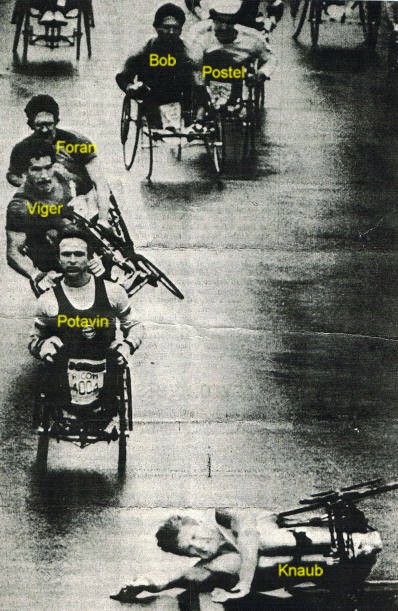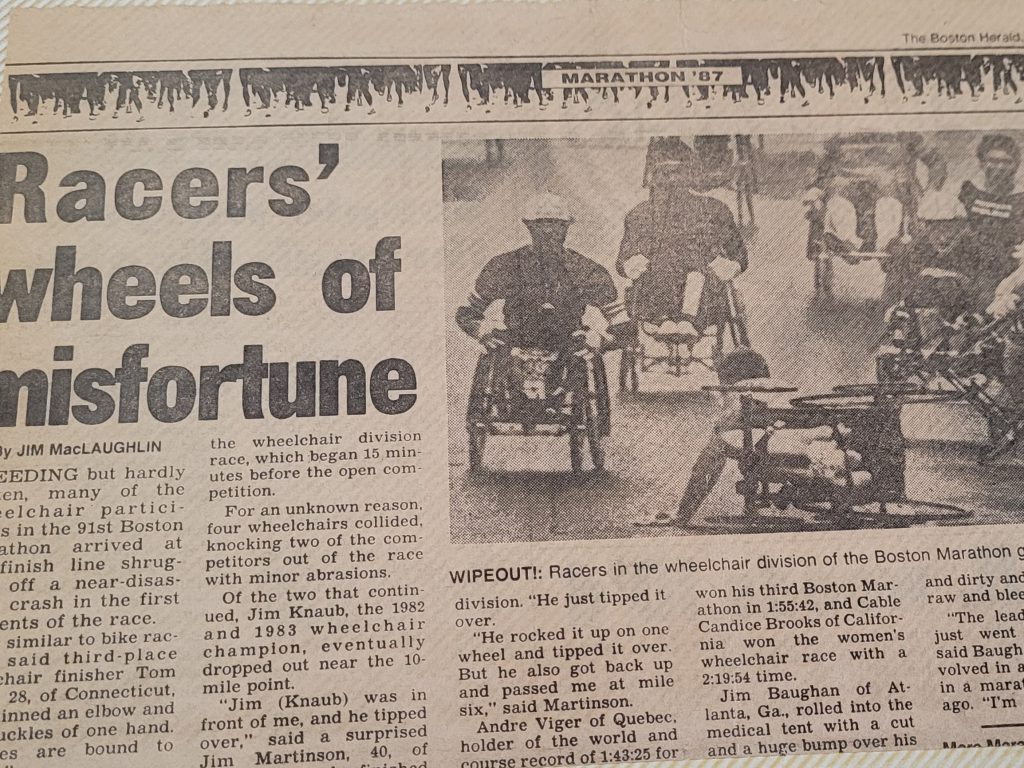Several years ago I had stumbled upon a picture from one of the Boston newspapers from perhaps the most dramatic crash in Wheelchair Racing history. In many ways, I liken this event to one of those Nascar crashes that changed the dynamics of our sport in many ways. The crash not only brought about alterations as to how we would be allowed to navigate the first mile or so of the Boston course, but also how we were perceived athletically. Horrendous as it was it brought to light a certain legitimacy about just how serious and dedicated we were about our desire to win.
Boston is just one of those courses that has layers of complexity to it. It begins in the rural town of Hopkinton with a start line that is for all intents and purposes pointed straight downhill. The pavement is rough and there is no shoulder on the road, so the consequences of leaving the road meant you would essentially be in the woods. Its a very hectic atmosphere, crowds cheering loudly, helicopters perched overhead, commands being barked and just general anxiety surrounds the first ten minutes. It was one of those cold and wet Boston’s. My recollection from 30 plus years ago was that it about 50 degrees and a steady drizzle. The 4 wheel race chairs we used were in such a state of technological change that we rarely had the same chair more than a year, often times less. This particular year there was significant concerns over a newly designed chair. I heard the grumblings and even low grade anxiety over how they might perform in the immediate decent. With no brakes, no helmets, a slick road with a constant drizzle we had a recipe for disaster, and boy did it happen.
As the gun went off all the top racers, hoping for the win hit the hand rims hard and went into a tuck. The first downhill could produce speeds of roughly 30 mph, however on this day I doubt we had hit more than 25 when the crash began. The only racer to get out in front of the impending carnage was previous winner, Jim Martinson. The crash started almost immediately. 2x winner, Jim Knaub was about 200 meters into the race when his chair went sideways and he laid it down. Keep in mind, there is no shoulder on this portion of the coruses road, so there was no place to bailout. One at a time, just as in car racing, we started to pile up on one another.

The carnage began literally seconds after the firing of the starters pistol when Jim Knaub went down and the rest was history.
Looking at the photo that appeared in all the Boston papers the next morning we were able to finally start making some sense of what had happened. The 3rd man in the shot, Canadian legend, Andre Viger had absolutely no chance of regaining control. Behind him, Tom Foran began his reaction and promptly move out in front of me. Tom was up 2 wheels, and if he had not pulled it together I was certain to end up a crash on a crash. Foran’s wheels hit the ground and we somehow, someway skirted out way around the whole mess. But you could hear the chairs grinding on the pavement, a sound you never forget. Now as a basic rookie I found myself running 3rd behind Foran and Martinson. Clearly outclassed I could hear Viger, who had been up righted barking orders behind me and I knew the big boys were coming. Viger went on to win that year, as did Candace Cable, however that was not the story. The story was the crash…period.
The fallout from 1987 brought about some real changes. First, it brought us some true legitimacy. I believe the able bodied community began to see that we had a passion to sacrifice life and limb to get a victory and moreover that we were not just in this for recreation and fun. The crash also brought about some significant safety changes. We were required to have brakes instead of trying to stop our chairs with heavily taped gloves, we needed to wear a helmet, and Boston race directors initiated the “controlled start.” The controlled start had its good and bad aspects as we were required to follow a pace car at less than 20mph down the first hill. This alone was not an easy skill as we were position only inches apart. At the time however it was a prudent rule.
As the years went by the 3 wheel racer technology combined with increased skill levels made it safer to just let the chair go full out right from the start. I guarantee that you could get 30 individual stories about the “87 Boston Crash.” It was a day none of us who were there will ever forget.

The local Boston papers did more to cover the crash than the chair division had ever had previously.

A slightly different perspective. Bob Hall, pictured in the zebras stripe suit goes from center of the road to far left in a matter of seconds!